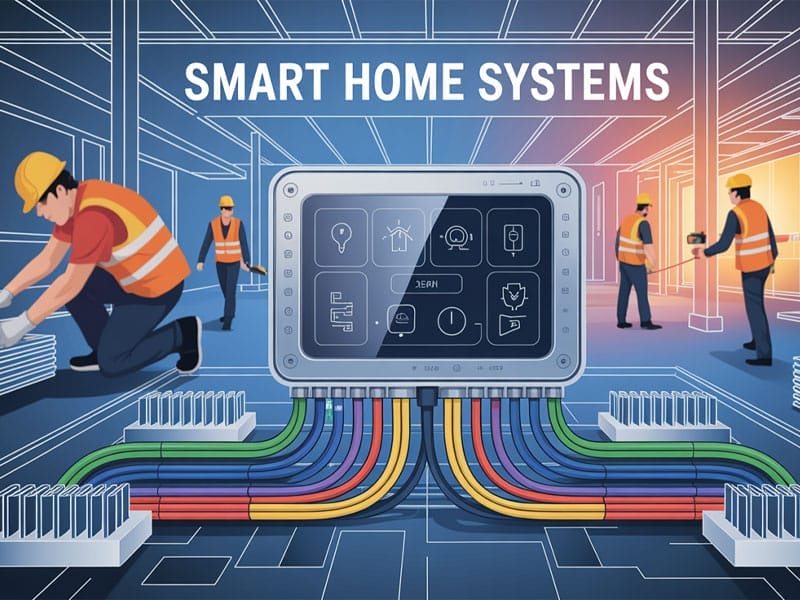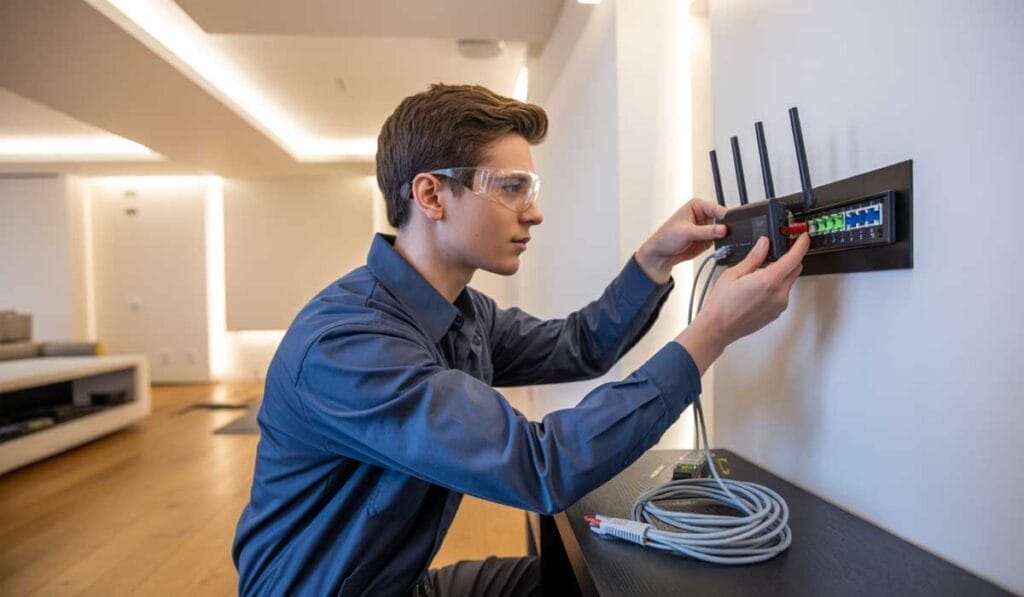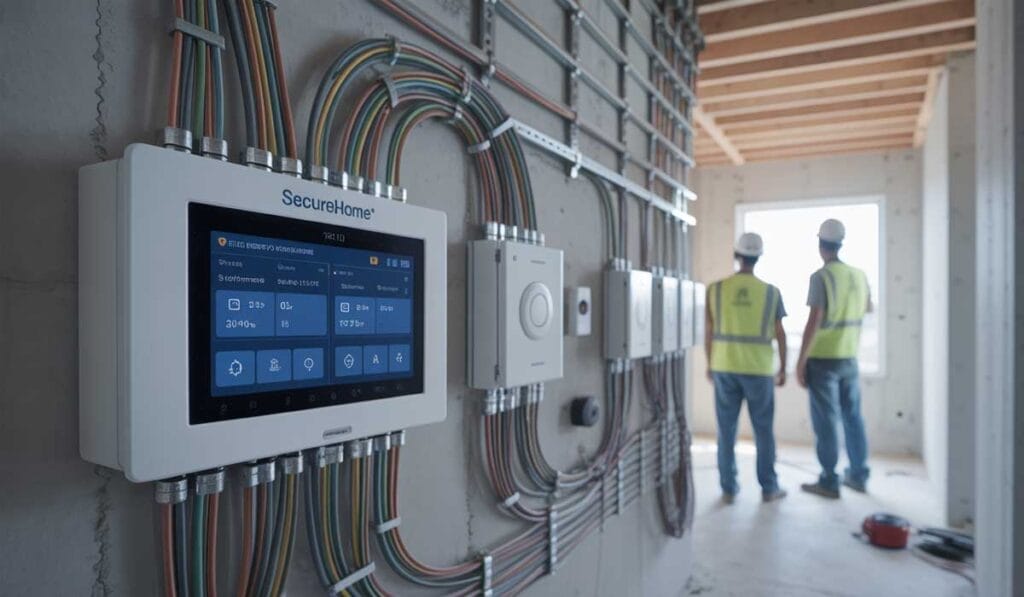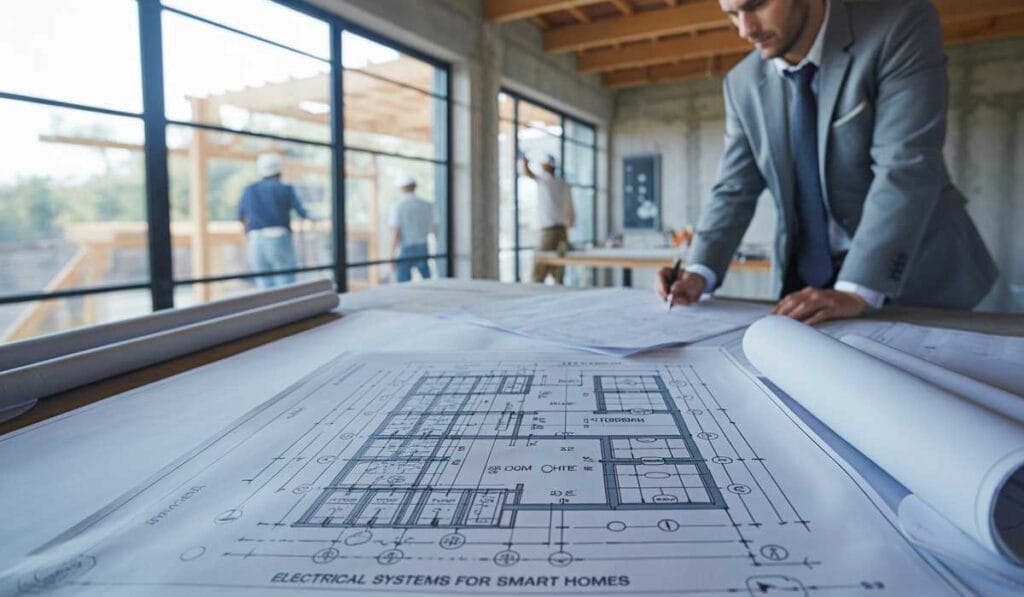
How To Plan Electrical Systems For Smart Homes In New Construction Projects
Planning the electrical system for a smart home can feel like solving a puzzle.
Smart home technology has grown fast, with devices like smart thermostats and security cameras becoming household staples.
This guide will help you design an efficient setup, from wiring to automation systems.
Key Takeaways
- Install CAT6 cables for fast internet and reliable smart device connections. Add fiber-optic cables if preparing for future tech needs is a priority.
- Place Wi-Fi access points centrally and avoid enclosed spots to maintain strong signals throughout the home.
- Use conduits to allow easy wiring upgrades without tearing down walls as new smart devices emerge.
- Plan neutral wires at all switches to support modern gadgets like smart thermostats and motion sensors.
- Pre-wire areas for security cameras, alarms, speakers, and TVs while labeling clearly to simplify installation later.
Start with a Comprehensive Electrical Design Plan

A well-thought-out electrical design plan sets the stage for success.
Map out every outlet, lighting fixture, and power supply.
Work closely with homeowners to understand their needs for smart home devices like smart locks, thermostats, and kitchen appliances.
Install neutral wires at all switch locations to support modern systems—smart switches need them.
Think ahead for heavy loads or future upgrades.
Smart homes often require additional circuits for connected devices such as security cameras or motion sensors.
Use CAT6 cables and fiber-optic lines to handle high-speed internet access and Power over Ethernet capabilities.
Include surge protectors in panels to guard against power spikes. “Good wiring today avoids headaches tomorrow.
Design for Smart Home Connectivity
Smart home systems thrive on strong connections.
Plan your wiring carefully, so every device works without a hitch.
Wiring for Wi-Fi and Internet

Install Cat6 cables to support fast and reliable home networks.
These cables handle high-speed data transfer, which is ideal for smart appliances and streaming.
Fiber-optic cables are an excellent upgrade if preparing for future needs is a priority.
Place wireless access points in central areas for strong Wi-Fi coverage.
Avoid corners or enclosed spaces like closets, as they weaken signals.
Add Ethernet ports near televisions, desks, or server racks to connect devices directly.
Reliable wiring prevents lagging smart home systems and enhances connectivity for tablets, smartphones, and voice assistants.
Placement of Smart Lighting and Switches

Place smart lighting where people need control the most.
Entryways, hallways, and kitchens are key spots. Use dimmable LED bulbs for energy efficiency and better lighting control.
Plan switches close to doorframes or common reach points.
“Smart homes shine brightest with well-placed ligMotion
Motion sensors in closets and bathrooms should be considered for automatic control.
Always include a neutral wire at switch locations for compatibility with smart devices.
Label wiring clearly to simplify future connections or upgrades.
Smart lights paired with smartphone apps make remote control seamless!
Integration of Home Automation Systems

Smart home wiring must connect all devices seamlessly. Use Cat6 cables for fast and reliable connections.
Ensure smart thermostats, lighting control systems, and wireless network access points communicate efficiently.
Focus on integrating smart appliances like intelligent HVAC systems or video surveillance tools into the electrical panel setup.
Add neutral wires during installation to support future upgrades without major disruption.
Plan for Audio-Visual and Entertainment Systems
Bring your entertainment to life with smart wiring for sound systems and video, making every movie night or playlist pop.
Wiring for Speakers and Televisions

Run Cat6 cables to every room where a television or sound system might go.
These wires help keep signals strong and reliable.
Place speaker wiring in walls and ceilings for a clean look.
Use proper cable management to avoid tangled messes later.
Think ahead about placement for surround sound or smart speakers.
Pre-wire zones so future smart home technologies fit with ease.
Label all connections at the electrical panels clearly.
This step saves time during installation and avoids headaches down the line!
Placement of Data Ports

Install data ports near televisions, workstations, and entertainment centers.
This supports smart appliances, Ethernet networks, and streaming devices.
Place them close to fixtures like smart security cameras or Wi-Fi access points for seamless connectivity.
Consider using Cat6 cables for reliability and faster internet speeds.
Leave room by outlets for future upgrades or adding intelligent home tech later.
Keep wiring neat with conduits to avoid messy tangles during installation or repairs.
Incorporate Security and Safety Features
Add wiring for cameras and alarms early, so your smart home feels as safe as a locked vault.
Wiring for Security Cameras
Run CAT6 cables to key spots like doors, windows, and garages.
These locations are high-traffic areas where motion detection is most effective.
Leave extra slack for adjustments and avoid sharp bends to prevent signal loss.
Install a separate breaker to power the cameras safely.
This helps reduce interference from other electrical connections.
Plan routes carefully for access control systems or smart locks linked with your security setup.
Integration of Alarm Systems

Alarm systems need proper wiring for smooth operation.
Plan for motion sensors, smart locks, and security lighting early in the project.
Install neutral wires to support advanced technology like wireless alarm connections or smart home networks.
Use CAT6 cables to link alarms with other devices in your smart home setup.
Place control panels that are easy to access but out of reach from burglars.
Add surge protection to safeguard equipment during power spikes.
Work with electrical engineers when designing complex setups for large homes or interconnected home automation systems.
Future-Proof the Electrical System
Think ahead—design smart home wiring that grows with tech trends, like adding Cat6 cables or extra conduits for upgrades.
Allow for Scalability and Upgrades
Choose a neutral wire setup. This supports modern gadgets like smart thermostats and updated motion sensors.
Add wireless access points for better coverage as families add devices over time.

Use Conduits for Flexible Wiring
Use conduits with enough room for extra wires.
This helps handle upgrades like Cat6 cables for faster internet or new smart lighting setups.
PVC and metal options work well; pick what suits the project best.
A clear path means smoother installs later on!
Conclusion

Planning electrical systems for smart homes takes effort but pays off.
Think ahead about smart lighting, security cameras, and Wi-Fi wiring.
Make room for upgrades with flexible setups like conduits and Cat6 cables.
Smart appliances and home automation need reliable connections, too.
A well-thought-out plan keeps the home efficient, safe, and ready for future tech!
FAQs
1. What should I consider when planning smart home wiring for new construction?
Plan for smart devices like smart lighting, thermostats, and appliances. Use Cat6 cables for strong connections and include a neutral wire to support advanced systems.
2. How can I improve wireless technology in my smart home?
Install wireless access points in key areas to boost coverage. This will help connect security cameras, motion sensors, and other devices without interruption.
3. Why is professional installation important for home automation systems?
Professionals know how to safely and efficiently set up complex systems such as intercoms, communication networks, and heating or cooling controls.
4. What steps can protect against phishing scams or email hoaxes?
Use strong passwords on all smart locks, meters, and devices. Keep software updated to block cyber threats targeting your network.
5. How do energy-efficient features fit into a modern electrical plan?
Smart meters track usage while automated lighting and thermostats reduce waste by adjusting settings based on activity or time of day.
